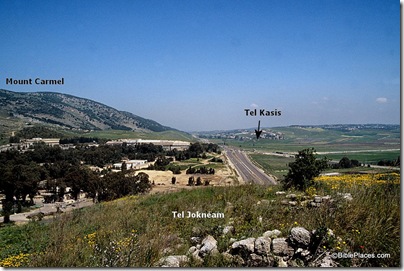From the Jerusalem Post:
A major 3,500 year old archaeological find was made at Tel Kasis dig near the Tishbi Junction in the North, the Israel Antiquities Authority announced Monday.
The site was found to include over 100 undamaged religious utensils, including tableware such as cups and plates, vessels for storing oils and statuettes some of which were imported from Mykonos in Greece.
The brief story continues here. A photo from the lab is posted here. Tel Kasis is located 1.5 miles (2.4 km) due north of Tel Jokneam, astride the “Kishon Pass” between Mount Carmel and the Shephelah of Galilee.
The Israel Antiquities Authority has issued a press release with more detail and half a dozen photographs showing some of the outstanding finds.
In the past the ancients would descend into the rock-hollow by way of two broad, hewn steps. Inside the cavity whole vessels were found piled one atop the other and other vessels were broken by those that had been placed upon them. Among the finds that were recovered: a cultic vessel that was used for burning incense, a sculpted face of a woman that was part of a cultic cup used in dedicating a libation to a god, goblets and bowls with high bases and tableware that was intended for eating and drinking. Other vessels that were found had been brought from Mycenae in Greece, including a storage vessel for precious oils – evidence of the ancient trade relations that existed with Greece.
According to archaeologists Uzi Ad and Dr. Edwin van den Brink, the excavation directors on behalf of the Israel Antiquities Authority, this is an extremely rare discovery. Until now no such pits as these have been found from 3,500 years ago. It is also extraordinary to find scores of vessels that are in such a good state of preservation. In most excavations fragments of pottery vessels are found, whereas here the vessels were removed from the rock-hollow intact. Each object was removed with the greatest of care, was drawn and documented and revealed beneath it a wealth of other finds. The vessels are numbered and their precise location in the heap is recorded for future research. According to the archaeologists, it is obvious that considerable time and thought were invested in the placement of the vessels in the rock-hollow, as evidence by the different kinds of vessels that were buried separately.
The complete press release and photos are here. Anson Rainey identifies the site (also spelled Tell el-Qassis) with Helkath (Josh 19:25; 21:31), a Levitical city on the southern tip of the tribal territory of Asher (The Sacred Bridge, 183).
UPDATE (6/9): Discovery News has posted an audio slide show, featuring an explanation by one of the excavators and some outstanding photographs. HT: Joe Lauer
